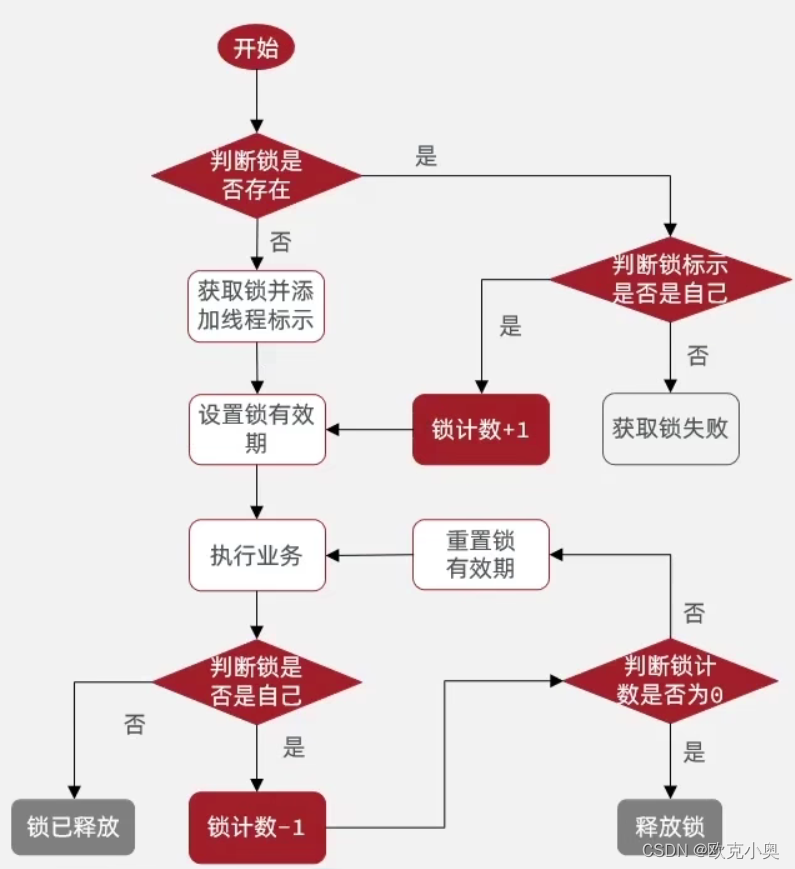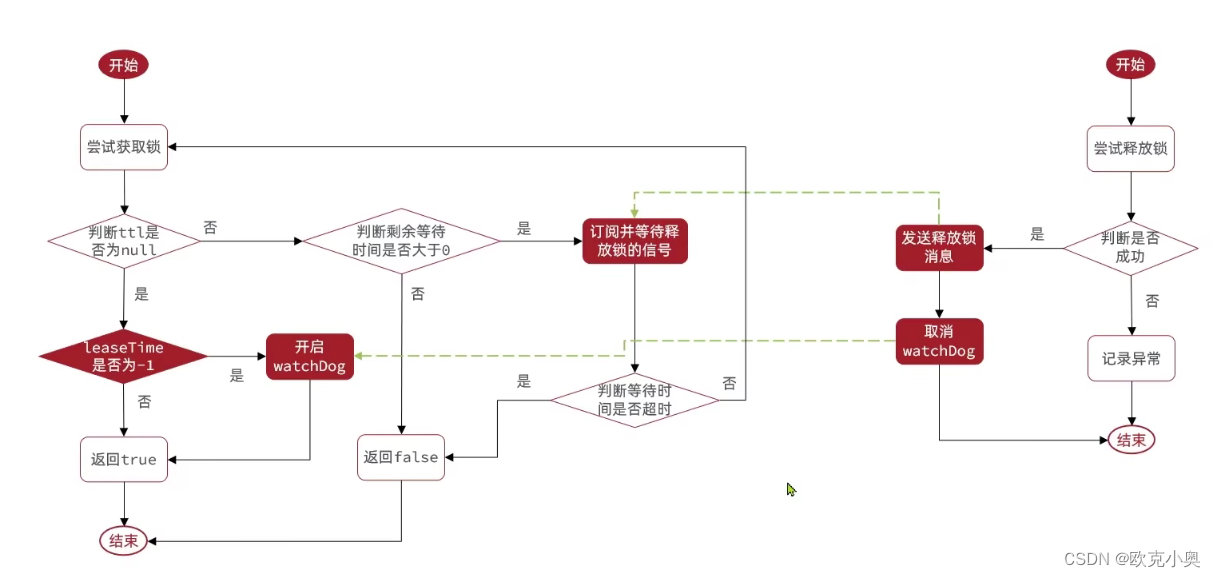Redisson分布式锁源码篇
☆* o(≧▽≦)o *☆嗨~我是小奥🍹
📄📄📄个人博客:小奥的博客
📄📄📄CSDN:个人CSDN
📙📙📙Github:传送门
📅📅📅面经分享(牛客主页):传送门
🍹文章作者技术和水平有限,如果文中出现错误,希望大家多多指正!
📜 如果觉得内容还不错,欢迎点赞收藏关注哟! ??
文章目录
Redisson分布式锁源码篇
Redisson 是一个简单的Redis Java客户端,具有内存数据网格功能。
它不仅提供了一系列的分布式的Java常用对象,还提供了许多分布式服务,其中就包含了各种分布式锁的实现。
GitHub地址:https://github.com/redisson/redisson
Redisson分布式锁不仅是相对成熟的分布式锁方案,而且在很多企业中都会去使用的,所以了解一下底层的实现还是很有必要的。
一、使用Redisson分布式锁
Redisson分布式锁的使用非常简单,我们只需要在maven中引入依赖,然后直接调用相关API即可。
1.1 引入依赖
<dependency>
<groupId>org.redisson</groupId>
<artifactId>redisson</artifactId>
<version>3.13.6</version>
</dependency>
1.2 调用API
// 创建RedissonClient
RedissonClient redissonClient = Redisson.create();
// 创建分布式锁
RLock lock = redissonClient.getLock("lock");
// 加锁
lock.lock();
// 尝试获取锁,无参表示不等待立即返回
boolean b = lock.tryLock();
// 解锁
lock.unlock();
二、源码解析
下面我就带大家去分析一下Redisson的可重入和可重试的源码。
2.1 可重入锁原理
(1) 原理解释
Redisson分布式锁的可重入锁的原理:
- 使用Redis中Hash的
key-value结构,存储线程标识和重入次数; - 每次获取锁的时候,如果线程标识相同,就给Hash的value加1;
- 每次释放锁的时候,并不会删除锁,而是重入次数减1;
- 当所有逻辑执行完,如果重入次数为0,则删除锁。
逻辑流程图

(2) 源码分析
① 尝试获取锁
// 尝试获取锁,无参表示不等待立即返回
boolean b = lock.tryLock();
org.redisson.RedissonLock
@Override
public boolean tryLock() {
return get(tryLockAsync());
}
@Override
public RFuture<Boolean> tryLockAsync() {
return tryLockAsync(Thread.currentThread().getId());
}
@Override
public RFuture<Boolean> tryLockAsync(long threadId) {
// tryAcquireOnceAsync有三个参数
// long waitTime 锁重试的最大等待时间
// long leaseTime 锁自动释放时间
// TimeUnit unit 时间单位
// long threadId 线程id
return tryAcquireOnceAsync(-1, -1, null, threadId);
}
注意,下面的代码我们只需要关注有注释的部分,剩余的部分会在后面讲到。
// 根据tryAcquireOnceAsync命名可知,这里获取锁只会获取一次,不会进行重试
private RFuture<Boolean> tryAcquireOnceAsync(long waitTime, long leaseTime, TimeUnit unit, long threadId) {
// 判断leaseTime是否为-1(leaseTime为锁自动释放的时间,如果不传默认为-1)
if (leaseTime != -1) {
return tryLockInnerAsync(waitTime, leaseTime, unit, threadId, RedisCommands.EVAL_NULL_BOOLEAN);
}
// tryLockInnerAsync是尝试获取锁的方法
RFuture<Boolean> ttlRemainingFuture = tryLockInnerAsync(waitTime,
commandExecutor.getConnectionManager().getCfg().getLockWatchdogTimeout(),
TimeUnit.MILLISECONDS, threadId, RedisCommands.EVAL_NULL_BOOLEAN);
ttlRemainingFuture.onComplete((ttlRemaining, e) -> {
if (e != null) {
return;
}
// lock acquired
if (ttlRemaining) {
scheduleExpirationRenewal(threadId);
}
});
return ttlRemainingFuture;
}
tryLockInnerAsync()方法是获取锁的主要实现,我们可以看到,其实都是固定的Lua脚本逻辑。
// 尝试获取锁的逻辑(重点)
<T> RFuture<T> tryLockInnerAsync(long waitTime, long leaseTime, TimeUnit unit, long threadId, RedisStrictCommand<T> command) {
internalLockLeaseTime = unit.toMillis(leaseTime);
return evalWriteAsync(getName(), LongCodec.INSTANCE, command,
"if (redis.call('exists', KEYS[1]) == 0) then " +
"redis.call('hincrby', KEYS[1], ARGV[2], 1); " +
"redis.call('pexpire', KEYS[1], ARGV[1]); " +
"return nil; " +
"end; " +
"if (redis.call('hexists', KEYS[1], ARGV[2]) == 1) then " +
"redis.call('hincrby', KEYS[1], ARGV[2], 1); " +
"redis.call('pexpire', KEYS[1], ARGV[1]); " +
"return nil; " +
"end; " +
"return redis.call('pttl', KEYS[1]);",
Collections.singletonList(getName()), internalLockLeaseTime, getLockName(threadId));
}
我们把这段Lua脚本摘出来分析一下逻辑:
-- 判断锁是否存在
if (redis.call('exists', KEYS[1]) == 0) then
-- 等于0表示不存在,创建锁,设置过期时间
redis.call('hincrby', KEYS[1], ARGV[2], 1);
redis.call('pexpire', KEYS[1], ARGV[1]);
return nil;
end;
-- 判断锁标识是否相同
if (redis.call('hexists', KEYS[1], ARGV[2]) == 1) then
-- 等于1表示是自己的锁,重试次数加1,设置过期时间
redis.call('hincrby', KEYS[1], ARGV[2], 1);
redis.call('pexpire', KEYS[1], ARGV[1]);
return nil;
"end;
return redis.call('pttl', KEYS[1]);
② 释放锁
// 释放锁
lock.unlock();
org.redisson.RedissonLock
@Override
public void unlock() {
try {
get(unlockAsync(Thread.currentThread().getId()));
} catch (RedisException e) {
if (e.getCause() instanceof IllegalMonitorStateException) {
throw (IllegalMonitorStateException) e.getCause();
} else {
throw e;
}
}
同样地,我们只需要跟着有注释的代码往下看。
@Override
public RFuture<Void> unlockAsync(long threadId) {
RPromise<Void> result = new RedissonPromise<Void>();
// unlockInnerAsync 是释放锁的方法
RFuture<Boolean> future = unlockInnerAsync(threadId);
future.onComplete((opStatus, e) -> {
cancelExpirationRenewal(threadId);
if (e != null) {
result.tryFailure(e);
return;
}
if (opStatus == null) {
IllegalMonitorStateException cause = new IllegalMonitorStateException("attempt to unlock lock, not locked by current thread by node id: "
+ id + " thread-id: " + threadId);
result.tryFailure(cause);
return;
}
result.trySuccess(null);
});
return result;
}
unlockInnerAsync()方法是释放锁的主要逻辑。我们可以看到,其实也都是固定的Lua脚本逻辑。
protected RFuture<Boolean> unlockInnerAsync(long threadId) {
return evalWriteAsync(getName(), LongCodec.INSTANCE, RedisCommands.EVAL_BOOLEAN,
"if (redis.call('hexists', KEYS[1], ARGV[3]) == 0) then " +
"return nil;" +
"end; " +
"local counter = redis.call('hincrby', KEYS[1], ARGV[3], -1); " +
"if (counter > 0) then " +
"redis.call('pexpire', KEYS[1], ARGV[2]); " +
"return 0; " +
"else " +
"redis.call('del', KEYS[1]); " +
"redis.call('publish', KEYS[2], ARGV[1]); " +
"return 1; " +
"end; " +
"return nil;",
Arrays.asList(getName(), getChannelName()), LockPubSub.UNLOCK_MESSAGE, internalLockLeaseTime, getLockName(threadId));
}
我们把这段Lua脚本摘出来分析一下逻辑:
-- 判断锁是否存在
if (redis.call('hexists', KEYS[1], ARGV[3]) == 0) then
-- 等于0表示不存在,直接返回
return nil;
end;
-- 锁重入次数减1
local counter = redis.call('hincrby', KEYS[1], ARGV[3], -1);
if (counter > 0) then
-- 如果锁重入次数大于0,则设置过期时间
redis.call('pexpire', KEYS[1], ARGV[2]);
return 0;
else
-- 如果锁重入次数等于0,则删除锁,并发布通知
redis.call('del', KEYS[1]);
redis.call('publish', KEYS[2], ARGV[1]);
return 1;
end;
return nil;
2.2 锁重试和watch dog原理
(1) 原理解释
Redisson分布式锁的锁重试和watch dog的原理:
获取锁
- 首先尝试根据线程标识获取锁
- 判断锁的ttl是否为null(为null表示成功获取到锁,不为null表示获取锁失败)
- 获取锁成功,判断锁自动释放的时间是否未设置(-1)
- 未设置,开启watch dog,进行自动续约
- 设置则使用设置的时间
- 获取锁失败,判断剩余等待时间是否大于0
- 大于0,订阅并等待释放锁的信号,并进行重试逻辑
- 小于等于0,则获取锁失败,返回
- 获取锁成功,判断锁自动释放的时间是否未设置(-1)
释放锁
- 首先尝试根据线程标识释放锁
- 释放锁成功,发送释放锁的消息,并关闭watch dog自动续约
- 释放锁失败,记录异常,返回

(2) 源码分析
① 重试获取锁
// 尝试获取锁,并设定获取锁的最大等待时长为1s
boolean b = lock.tryLock(1, TimeUnit.SECONDS);
org.redisson.RedissonLock
@Override
public boolean tryLock(long waitTime, TimeUnit unit) throws InterruptedException {
return tryLock(waitTime, -1, unit);
}
@Override
public boolean tryLock(long waitTime, long leaseTime, TimeUnit unit) throws InterruptedException {
long time = unit.toMillis(waitTime); // 将等待时间转化为ms
long current = System.currentTimeMillis(); // 当前时间
long threadId = Thread.currentThread().getId(); // 线程ID
// tryAcquire是尝试获取锁的方法,ttl表示锁的剩余有效期
Long ttl = tryAcquire(waitTime, leaseTime, unit, threadId);
// lock acquired
if (ttl == null) {
// 如果ttl为null,则表示获取锁成功,返回true
return true;
}
// 否则获取锁失败,需要重试
// 这里减去获取锁消耗的时间,防止获取锁时间过长超过了等待时间
time -= System.currentTimeMillis() - current;
if (time <= 0) {
// 如果等待时间小于0,则返回false,获取锁失败
acquireFailed(waitTime, unit, threadId);
return false;
}
// 这里等待时间还有剩余,可以进行继续尝试获取锁
current = System.currentTimeMillis(); // 当前时间
// 订阅释放锁的信号(如果锁被释放,则这里会收到通知,通知的逻辑在释放锁的lua脚本中执行,publish操作)
RFuture<RedissonLockEntry> subscribeFuture = subscribe(threadId);
// await方法为等待,等待时间为time
if (!subscribeFuture.await(time, TimeUnit.MILLISECONDS)) {
// 如果等待time时间,还没有收到释放锁通知
if (!subscribeFuture.cancel(false)) {
subscribeFuture.onComplete((res, e) -> {
if (e == null) {
unsubscribe(subscribeFuture, threadId); // 取消释放锁信号的订阅
}
});
}
acquireFailed(waitTime, unit, threadId);
return false; // 获取锁失败,返回false
}
// 这里已经获取到释放锁的通知
try {
// 减去等待消耗的时间
time -= System.currentTimeMillis() - current;
if (time <= 0) {
// 如果等待时间小于0,则返回false,获取锁失败
acquireFailed(waitTime, unit, threadId);
return false;
}
while (true) {
long currentTime = System.currentTimeMillis();
// 重试获取锁的逻辑,与上面类似
ttl = tryAcquire(waitTime, leaseTime, unit, threadId);
// lock acquired
if (ttl == null) {
return true;
}
time -= System.currentTimeMillis() - currentTime;
if (time <= 0) {
acquireFailed(waitTime, unit, threadId);
return false;
}
// waiting for message
currentTime = System.currentTimeMillis();
// 以信号量机制的方式尝试获取
// ttl为锁剩余时间,time为等待时间
if (ttl >= 0 && ttl < time) {
// 如果ttl < time,只会等待ttl时间
subscribeFuture.getNow().getLatch().tryAcquire(ttl, TimeUnit.MILLISECONDS);
} else {
// 否则等待time
subscribeFuture.getNow().getLatch().tryAcquire(time, TimeUnit.MILLISECONDS);
}
time -= System.currentTimeMillis() - currentTime;
if (time <= 0) {
acquireFailed(waitTime, unit, threadId);
return false;
}
// 时间充足,继续重试
}
} finally {
unsubscribe(subscribeFuture, threadId); // 取消订阅
}
// return get(tryLockAsync(waitTime, leaseTime, unit));
}
private Long tryAcquire(long waitTime, long leaseTime, TimeUnit unit, long threadId) {
// 这里的get其实就是阻塞等待返回锁的剩余有效期(如果存在,不存在返回null)
return get(tryAcquireAsync(waitTime, leaseTime, unit, threadId));
}
private <T> RFuture<Long> tryAcquireAsync(long waitTime, long leaseTime, TimeUnit unit, long threadId) {
if (leaseTime != -1) {
return tryLockInnerAsync(waitTime, leaseTime, unit, threadId, RedisCommands.EVAL_LONG);
}
// RFuture,表示这里使用异步的方式去执行获取锁的逻辑
RFuture<Long> ttlRemainingFuture = tryLockInnerAsync(waitTime,
// 如果不设置默认时间,则在这里给定默认值,默认值为30s
// private long lockWatchdogTimeout = 30 * 1000;
commandExecutor.getConnectionManager().getCfg().getLockWatchdogTimeout(),
TimeUnit.MILLISECONDS, threadId, RedisCommands.EVAL_LONG);
// 当RFuture完成以后
ttlRemainingFuture.onComplete((ttlRemaining, e) -> {
// ttlRemaining表示剩余有效期,e表示异常
if (e != null) {
return;
}
// ttlRemaining == null,表示获取锁成功
if (ttlRemaining == null) {
// 解决有效期问题,即过期时间续约
scheduleExpirationRenewal(threadId);
}
});
return ttlRemainingFuture;
}
<T> RFuture<T> tryLockInnerAsync(long waitTime, long leaseTime, TimeUnit unit, long threadId, RedisStrictCommand<T> command) {
// 将leaseTime转化为ms赋值给内部的成员变量
internalLockLeaseTime = unit.toMillis(leaseTime);
return evalWriteAsync(getName(), LongCodec.INSTANCE, command,
"if (redis.call('exists', KEYS[1]) == 0) then " +
"redis.call('hincrby', KEYS[1], ARGV[2], 1); " +
"redis.call('pexpire', KEYS[1], ARGV[1]); " +
"return nil; " +
"end; " +
"if (redis.call('hexists', KEYS[1], ARGV[2]) == 1) then " +
"redis.call('hincrby', KEYS[1], ARGV[2], 1); " +
"redis.call('pexpire', KEYS[1], ARGV[1]); " +
"return nil; " +
"end; " +
// 这里返回的是 锁的剩余有效期,单位为ms
"return redis.call('pttl', KEYS[1]);",
Collections.singletonList(getName()), internalLockLeaseTime, getLockName(threadId));
}
② watch dog自动续约
定时更新有效期的方法是在获取锁成功之后调用的,方法名为scheduleExpirationRenewal。
private static final ConcurrentMap<String, ExpirationEntry> EXPIRATION_RENEWAL_MAP = new ConcurrentHashMap<>();
// name是锁的名称
public RedissonLock(CommandAsyncExecutor commandExecutor, String name) {
...
this.id = commandExecutor.getConnectionManager().getId(); // 当前连接id
...
this.entryName = id + ":" + name;
...
}
protected String getEntryName() {
return entryName;
}
// 解决有效期问题,即过期时间续约
private void scheduleExpirationRenewal(long threadId) {
ExpirationEntry entry = new ExpirationEntry();
// EXPIRATION_RENEWAL_MAP是一个ConcurrentMap,key可以理解为就是锁的名称,entry就是锁的实例
ExpirationEntry oldEntry = EXPIRATION_RENEWAL_MAP.putIfAbsent(getEntryName(), entry);
if (oldEntry != null) {
// 同一个线程重入的情况
oldEntry.addThreadId(threadId);
} else {
// 线程第一次来
entry.addThreadId(threadId);
// 更新过期时间
renewExpiration();
}
}
// 更新过期时间
private void renewExpiration() {
ExpirationEntry ee = EXPIRATION_RENEWAL_MAP.get(getEntryName());
if (ee == null) {
return;
}
// 定时任务,有三个参数
// TimerTask 定时任务
// long delay 延迟时间
// TimeUnit unit 时间单位
Timeout task = commandExecutor.getConnectionManager().newTimeout(new TimerTask() {
@Override
public void run(Timeout timeout) throws Exception {
// 获取ExpirationEntry
ExpirationEntry ent = EXPIRATION_RENEWAL_MAP.get(getEntryName());
if (ent == null) {
return;
}
// 取出线程ID
Long threadId = ent.getFirstThreadId();
if (threadId == null) {
return;
}
// 刷新有效期
RFuture<Boolean> future = renewExpirationAsync(threadId);
future.onComplete((res, e) -> {
if (e != null) {
log.error("Can't update lock " + getName() + " expiration", e);
return;
}
if (res) {
// 重新执行自己的逻辑,这样的话,如果锁存在,就会自动续约,10s执行一次
renewExpiration();
}
});
}
// internalLockLeaseTime是内部锁释放时间(尝试获取锁的逻辑中赋值,是一个成员变量,即wtach dog默认时间30s)
// 这里表示该定时任务10s后执行
}, internalLockLeaseTime / 3, TimeUnit.MILLISECONDS);
ee.setTimeout(task);
}
// 刷新有效期
protected RFuture<Boolean> renewExpirationAsync(long threadId) {
return evalWriteAsync(getName(), LongCodec.INSTANCE, RedisCommands.EVAL_BOOLEAN,
"if (redis.call('hexists', KEYS[1], ARGV[2]) == 1) then " +
// 如果锁是当前线程的,则更新有效时间
"redis.call('pexpire', KEYS[1], ARGV[1]); " +
"return 1; " +
"end; " +
"return 0;",
Collections.singletonList(getName()),
internalLockLeaseTime, getLockName(threadId));
}
那么什么时候停止定时更新呢?
当然是在释放锁的过程中,我们回过来看释放锁的剩余代码:
@Override
public RFuture<Void> unlockAsync(long threadId) {
RPromise<Void> result = new RedissonPromise<Void>();
// unlockInnerAsync 是释放锁的方法
RFuture<Boolean> future = unlockInnerAsync(threadId);
// 释放锁完成后
future.onComplete((opStatus, e) -> {
// 取消到期更新任务
cancelExpirationRenewal(threadId);
if (e != null) {
result.tryFailure(e);
return;
}
if (opStatus == null) {
IllegalMonitorStateException cause = new IllegalMonitorStateException("attempt to unlock lock, not locked by current thread by node id: "
+ id + " thread-id: " + threadId);
result.tryFailure(cause);
return;
}
result.trySuccess(null);
});
return result;
}
void cancelExpirationRenewal(Long threadId) {
// 从map中获取到当前锁的定时任务
ExpirationEntry task = EXPIRATION_RENEWAL_MAP.get(getEntryName());
if (task == null) {
return;
}
if (threadId != null) {
// 从任务中移除线程id
task.removeThreadId(threadId);
}
if (threadId == null || task.hasNoThreads()) {
Timeout timeout = task.getTimeout();
if (timeout != null) {
// 将定时任务取消
timeout.cancel();
}
// 最后将entry移除
EXPIRATION_RENEWAL_MAP.remove(getEntryName());
}
}
这样,在锁被释放锁,所有的定时任务、订阅都被取消了。
本文来自互联网用户投稿,该文观点仅代表作者本人,不代表本站立场。本站仅提供信息存储空间服务,不拥有所有权,不承担相关法律责任。 如若内容造成侵权/违法违规/事实不符,请联系我的编程经验分享网邮箱:chenni525@qq.com进行投诉反馈,一经查实,立即删除!
- Python教程
- 深入理解 MySQL 中的 HAVING 关键字和聚合函数
- Qt之QChar编码(1)
- MyBatis入门基础篇
- 用Python脚本实现FFmpeg批量转换
- PHP基础 - 循环与条件语句
- 知识蒸馏 Knowledge Distillation(在tinybert的应用)
- 「许战海战略文库」火遍云南的单山蘸水,为什么打不开全国市场?
- DataLoader与Dataset
- 多模态情感分析——基于CMU-MOSI和CMU-MOSEI数据集(文末获取源码)
- 【已解决】Excel“打开密码”在哪里设置?
- Makefile实现工程管理文件
- (一)看参考手册学stm32基于hal库,点灯时钟配置
- golang开发--beego入门
- 静态网页设计——个人简介网站